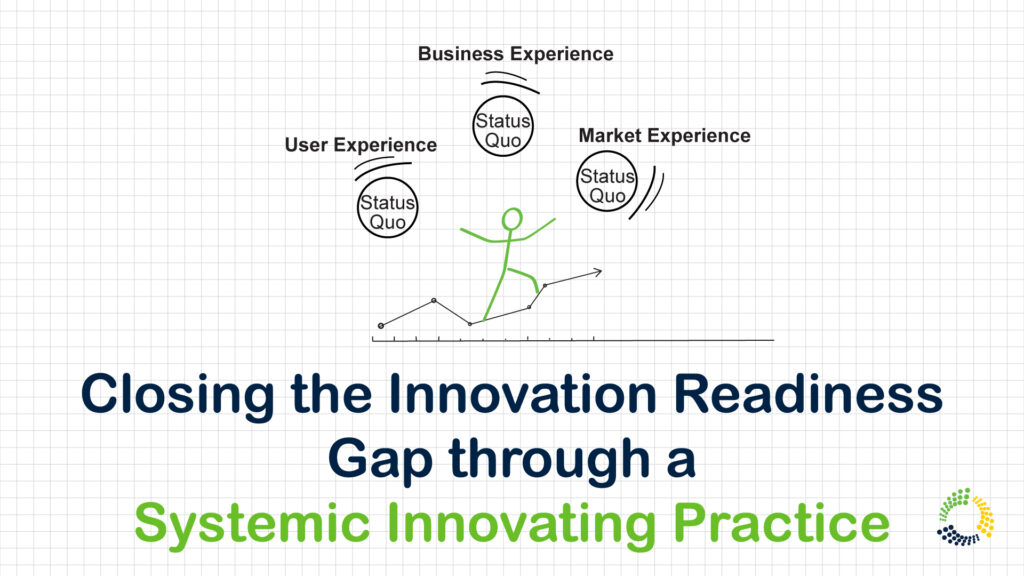
This edition of the Agile Innovating ™️ Newsletter is for Entrepreneurs and Business Leaders who want to improve their innovation outcomes.
The Boston Consulting Group, in studies conducted from 2005 to 2021, reported that 70% of the companies surveyed identified “Innovation” as a top 3 strategic priority, and that 90% of executives were dissatisfied with the performance of their Innovation Programs. BCG attributed this level of dissatisfaction to the fact that 80% of the companies surveyed did not have a systemic innovation practice. The lack of a systemic practice was dubbed a “Readiness Gap”.
In our own studies, we have quantified the impact of the “Readiness Gap”. Businesses without a systemic innovating practice achieve innovations in about 40% of their projects. Businesses with a systemic practice achieve innovations in excess of 75% of their projects.
This article identifies the structural elements of a systemic practice which close the “Readiness Gap”.
Closing the Innovation Readiness Gap through a Systemic Innovating Practice
A key factor involved in ensuring the long term health and stability of a business is its ability to generate new growth. Innovations are actively sought because they always anticipate generating new growth; specifically, growth in new Revenues, number of Customers, and Profits.
Most businesses engage in innovating; the practices, methodologies, and processes intended to create innovations. But, to the continuing frustration of all involved, innovating activities have a poor track record of achieving innovations. This isn’t because they are doing anything wrong, lack innovating skills, or because the practices, methodologies, and processes they use don’t work.
The most common reason is that a business’s Innovation Practice is incomplete. This incompleteness can be related to activities they don’t engage in, or to the activities they do engage in but have not organized into a business system, or both. In all three cases, innovating success rates are being held back by the aforementioned “Readiness Gap”.
Eliminating the “Readiness Gap” is the key that unlocks the potential of innovating activities, causing innovations to become the norm rather than the exception.
The Structure of an Innovation Business System
All high hit rate innovating practices get superior results from work in four disciplines:
- Sensemaking – understanding the market landscape, competitive situation, and existing solution life cycle dynamics to identify new growth opportunities
- Invention – imagining and creating new solution specifications relating to the opportunities
- Introduction – developing and deploying a new solution through-out the organization, making it available for sale and support
- Adoption – facilitating the customer trial, acceptance, and substitution process that replaces an existing solution with the new solution
Sensemaking
Sensemaking involves identifying the existing status quo in three environments by documenting the:
- User Experience with existing solutions based upon the Customer Jobs Being Done and existing Solution Specifications
- Business Experience with existing solutions based upon the Basis of Competition and your existing Business Capabilities
- Market Experience with existing solutions based upon your business’s Strategic Intent, Business Model, and Purpose, and the Customer Segmentation Profile
Sensemaking looks for opportunities to concurrently improve the User Experience, Business Experience, and Market Experience. By testing the opportunities found against the existing solution Life Cycle Dynamics, possible opportunities can be reduced to the opportunities that have a high probability of becoming innovations.
Invention
Invention applies imagination and creativity to high probability opportunities to generate new solution ideas. Ideas, when combined with enabling technologies, become testable concepts. Verified concepts become the foundation of new solution specifications that concentrate the organization’s people and resources on the development of the new solution and its associated new business capabilities.
Introduction
Introduction includes all the Development and Deployment activities engaged in by the entire organization to produce, support, and make the new solution available for sale. The New Solution Specification is the guiding requirement that creates the circumstances where high speed introduction is possible. The Specification also prevents new ideas from emerging during this time which, at best, slow Introduction down, and at worst, are fatal to the project.
Adoption
The ultimate result of every Innovation Project is the adoption of a new solution by customers. Adoption is a disciplined process of increasing customer engagement that starts with the awareness of the availability of a desirable new solution and ends with the substitution of the new solution in place of an existing solution.
Conclusion
Organizing the four disciplines into a systemic practice concentrates the attention of the organization on achieving the result that is characteristic of all innovations; the changing of the status quo in the Market, Solution, and Business environments.
Each of the four disciplines exercises a combination of individual skills and organizational processes to create a business capability that can become a competitive differentiator. That capability, institutionalized as a Innovation Business System, can be depended upon to reliably generate the new growth that all businesses need.
🌱
Systemic practice
Changing the three status quos
Cool Innovations
-Innovation Haiku, Kevin A Fee, February 21, 2024
